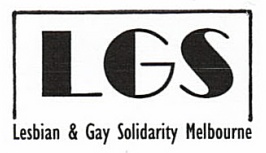



During 1999 Community Support Network (CSN) in the Hunter, a group within the AIDS Council of New South Wales (ACON) Hunter Branch, was approached by the Australian Quilt Project to do an educational display of some panels of the AIDS quilts at various high schools in the region. The approach was accompanied by a request that a talk be given to the children at the schools at which the display was to occur, to explain the significance of the Quilt Project, and the additional educational information concerning HIV/AIDS and World AIDS Day on 1 December annually internationally.
As long-time volunteers with CSN we were approached to give the talk, and the school selected was Mereweather High School in Newcastle.

Here is the talk, given on 14 October 1999 which was followed by a display of Quilt panels in the school hall:
George Shaekelford, curator of the Museum of Fine Arts in Houston, Texas, said "The quilt [is] one of the great memorials of our time - and one of history's most powerful works of political art."
In June 1987 a small group of strangers gathered in a San Francisco storefront to document the lives they feared history would neglect. Their goal was to create a memorial for those who had died of AIDS, and to thereby help people undertand the devastating impact of the disease. This meeting of devoted friends and lovers served as the foundation of the NAMES Project AIDS Memorial Quilt.
Today, 12 years later, the Quilt is a powerful visual reminder of the AIDS pandemic. Over 42 000 individual 3-by6-foot memorial panels - each one commemorating the life of someone who has died of AIDS - have been sewn together by friends, lovers and family members. The NAMES Project Foundation coordinates displays of portions of the Quilt worldwide.
Organisations in 37 countries from Argentina and Ireland to Thailand and Zambia, have adapted the idea of the Quilt to their own cultural traditions and use the Quilt in their work against HIV and AIDS. Through their efforts, they have created a rich, multicultural tapestry of the lives cut short by the global pandemic.
The QUILT PROJECT is a memorial to those lost in the AIDS epidemic. Composed of fabric panels, each in memory of an individual who has died of HIV/AIDS, it is a symbol of the humanity behind the epidemic statistics.
The panels measure 90x180cm (3'x6'), and are designed and made by lovers, family or friends.
The Quilt Project has four goals:
1) To provide a positive and creative means of expression for those whose lives have been touched by the HIV/AIDS epidemic, and to facilitate the grieving process.Inspired by the American NAMES PROJECT, based on the folk art traditions of quilting and sewing bees, the AUSTRALIAN AIDS MEMORIAL QUILT PROJECT was founded in September 1988 by Andrew Carter, OAM, and Richard Johnson, in Sydney. It was formally launched on World AIDS Day, 1 December 1988 by Ms Ita Buttrose. The founding 35 memorial panels were displayed that day with visiting panels from the American Names Project.
The Quilt is displayed regularly right across the country. Displays help people understand the names behind the statistics. They also help to dispel some of the prejudices and misinformation, and help to raise awareness of HIV/AIDS and promote a more comassionate understanding.
People also see the love, caring and hope of friends and family sewn in every stitch, and painted with every brushstroke.
Each panel is unique as the person it memorialises. Names, dates and personal information are often included, as well as favourite objects or special mementoes. Some panels clearly show the fear of prejudice, arriving without last names or other identifying details. Perhaps most importantly, creating a panel help people confront the pain and grief of their loss.
AIDS is a worldwide problem that knows no territorial or cultural boarders. It is a disease that can only be fought globally with global understanding. You can help by encouraging friends to create panels for their loved ones. Make a panel yourself. Your contribution will help bring about a truly international QUILT spirit.
The project has now reached the stage where a book has been written illustrating Hunter AIDS Quilt panels.
The book will be dedicated to, and in memory of, all our loved ones here in the Hunter Region who have died of HIV/AIDS.
The book is called the TWO STARS PROJECT and is due to be launched om World AIDS Day, 1 December 1999.
The production of this book relies solely on fundraising and donations. You can contribute to the production of this book through a donation, ideas and fundraising.
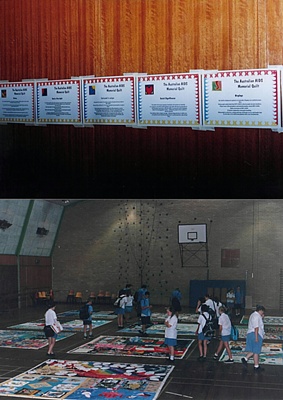
Quilt panels on the floor of the school hall where many students came to look at the panels. Of great interest is the fact that about 120 students came during their break to see the panels in a school of about 900 students, of whom about 100 were away on study break before their HSC exams. Only about 5 teachers at the school came to the hall from a staff of about 40.

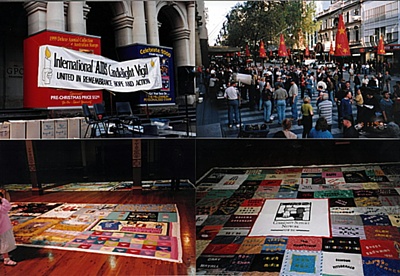
World AIDS Day in Melbourne 1999 - photos show gathering outside GPO Bourke Street Mall and AIDS Quilt Display in Exhibition Buildings, Carlton Gardens.

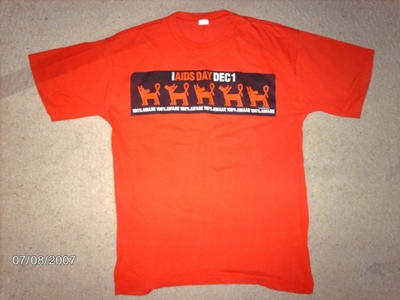

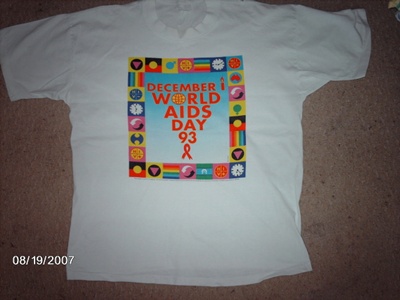

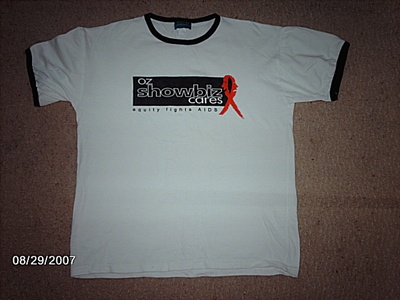

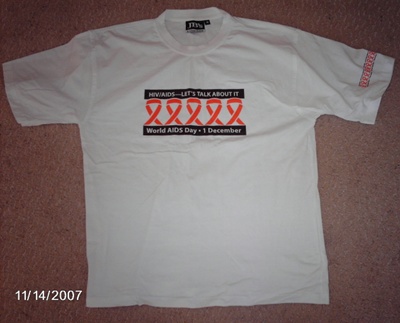

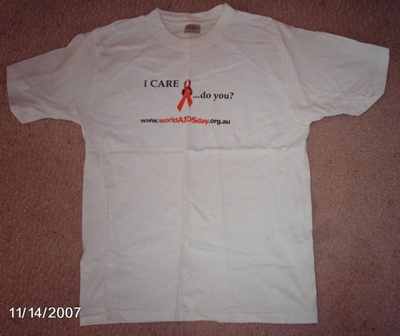

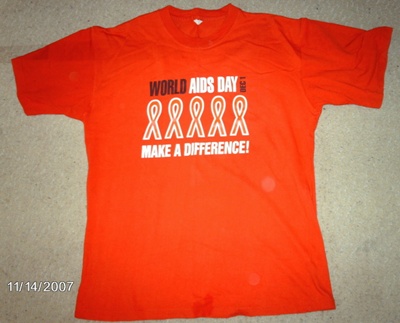



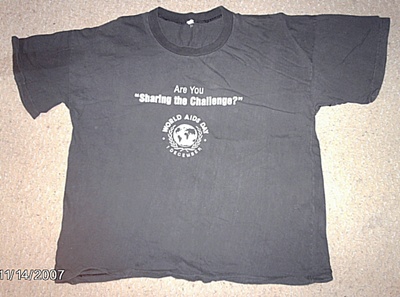

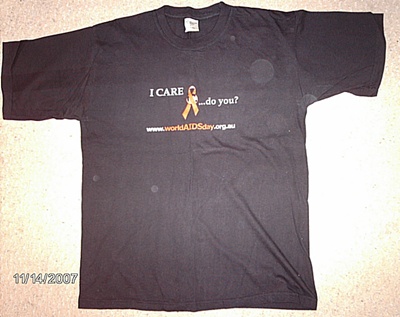

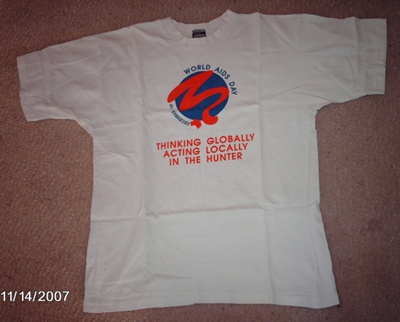



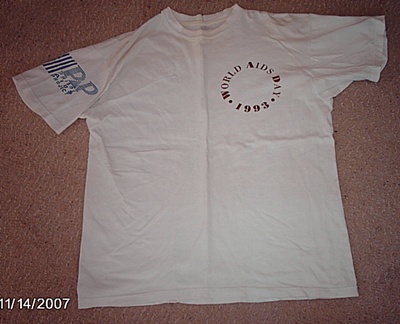



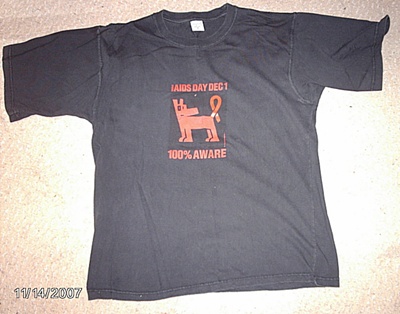

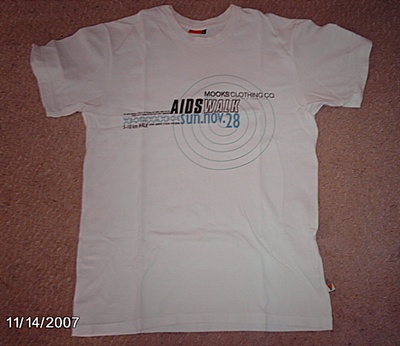

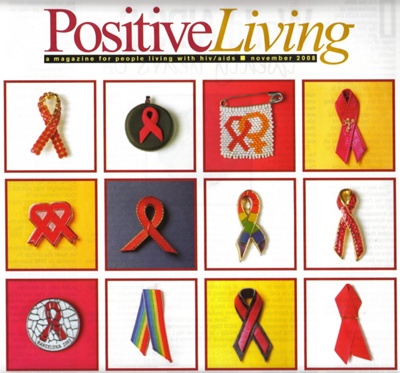


From Positive Living, November 2008 edition, as printed in MCV Issue 411, 20 November 2008

This letter is from The Age newspaper:
ON TUESDAY, the White House was bedecked in a large red ribbon in honour of World AIDS Day. How sad that this important day and its message passed with barely a mention in the Australian media and in Federal Parliament, when there are more than 17,000 Australians living with HIV/AIDS and a further 900 diagnosed with the virus each year.
Contrast this with the aftermath of the Black Saturday bushfires this year, in which every newspaper devoted pages of coverage to the disaster and it was practically un-Australian not to don a large yellow ribbon.
I wonder why World AIDS Day is not seen as just as tragic and worthy of recognition? Perhaps because it does not concern an issue that speaks only to ''working families''.
Ingrid Weinberg, North Caulfield
Thousands heading into an old age they did not think they would see, having given up jobs expecting to die young


In the 1980s and 1990s they were told they were going to die young, so they gave up their jobs and cashed in the pensions they wouldn't need, buried their friends and tried to make the most of their last months on Earth.
Decades later, thousands of men and women with HIV in the UK, US and across the world are heading into an old age they never expected to see. In the US in 2001, 17% of people with HIV were over 50. Now that figure stands at 39% and by 2017 it will be half. In the UK, the Health Protection Agency says one in six people (16.8%) being seen for HIV care in 2008 were over 50 – and that will double in the next five years.
Many of those who were saved by the discovery of antiretroviral drugs in the early 1990s felt it was a miracle to be alive. But life for the survivors of HIV, as they age, is bittersweet. Many are poor and have long since been edged out of the workforce. Half a lifetime spent on powerful drugs has taken its toll. Aside from the physical health issues as a result of the virus, there are high rates of mental health problems too.
John Rock, from Sydney, Australia, was diagnosed with HIV 30 years ago. "My partner started getting sick in 1983 and died early in 1996," he said at an international Aids conference in Washington DC. "Many of my colleagues and friends were pushed out of the workforce around the mid-90s because they were not well enough to work.
Subsequently triple combinations [of antiretroviral drugs] came along and they are still alive, but at the peak of their earning capacity they were out of the workforce for 10 years. Now they are destined for a retirement they thought they never would have, but it's going to be in poverty."
Lisa Power from the Terrence Higgins Trust (THT), who spoke at the conference about the ageing HIV-positive community in the UK, acknowledged the unfortunate consequences of advice from support groups to those who were thought to be dying. "In the 1980s and 90s we encouraged people to give up work and go on state benefits and not be economically productive," she said. "Now we have condemned people to live on an old-age state pension."
Money is not the only need. Many feel lonely and isolated. In a video made for a project called The Graying of HIV in the US, Bill Rydwels, 77, from Chicago, recalled a time of terror and sadness when Aids was scything down his friends. It was nonetheless a time of warmth and support that he no longer has. "It's just so much better today and yet it is a lonelier time. Years ago it was a time that we all spent together. It was a terrible time and a wonderful time because you got to know everybody very, very well. They cried on your shoulder and laughed with you. You don't get that any more."
Recent research from THT in the UK reveals similar sadness. James, 61, a gay man living in the UK who did not want to give his full name, is suffering from serious health problems, including blindness resulting from the use of an experimental drug to treat another condition (not HIV). "My life is empty," he told researchers. "I have tried so hard over the last 10 years to fill the emptiness. Worked really hard at it. I am in a cul-de-sac. It would be nice just to have somebody to telephone.
"I am fed up with people at the top of HIV organisations saying because there is combination therapy everyone is fine. People with neuropathy, and in wheelchairs, we are the forgotten people."
Half the world away, in Africa, which now bears the brunt of the epidemic, the numbers of older people with HIV are also rising fast. Epidemiologists at the University of Sydney estimate that there are more than 3 million people over 50 with HIV in sub-Saharan Africa, and that the figure is rising rapidly.
Ruth Waryero, from Kenya, now 65, had an HIV test when she was 48. She went home and told her husband. "He listened to me and then he got up and said, it's up to you.
"Take care of yourself – I'm off. Since that time I have not seen him again and yet he was the breadwinner in the family. He left me with the four children and two years later I had two grandchildren.
"In Kenya we have different problems [from those in Europe]. Older men try to get younger women for sex. They ignore you because as far as you are concerned, you are finished. You don't need sex and they can apply to the young girls.
"But when you are old you are likely to be raped by those who are positive because they believe if they rape you, as old as you are, they will turn negative."
Older women also face embarrassment at clinics when they go for tests or drugs, she said. They are asked who they are collecting the drugs for.
"You are not supposed to have sex at your age," she said. "As a woman they ask if you are a sugar mummy. I say this HIV came from an old man and the old man has run away from me."
The older HIV generation – in Africa and elsewhere – is not only made up of those diagnosed years ago. Some are people who have been diagnosed late, having lived for years without knowing they were infected. And many people are now becoming infected later in life.
Laura, who took part in the THT research, is a white, heterosexual, divorced mother of two. At the age of 52 she started a new relationship and then suddenly became ill. Because her symptoms were similar to those of a friend who had been diagnosed with HIV, she took a test. When she was told it was positive, she felt numbness and shock, she said. She cannot believe, as a well-educated person, that she stopped using condoms with her partner and allowed it to happen.
Mark Brennan-Ing, from the Aids Community Research Initiative of America, told the conference of the "fragile social networks among people living with HIV in the US and Europe". Families have abandoned them or do not give them enough help, meaning they end up relying on friends, who often have HIV themselves.
Men who have sex with men, he said, are much less likely to have partners, spouses or children to care for them in their old age. Many of those interviewed live in fear of encountering hostility and rejection in care homes. A 52-year-old gay man from London told the THT: "I am somewhat fearful of a lonely old age. In practical terms, if I become mentally or physically frail, the prospect of being the only gay man in an old people's home is very frightening indeed."

Article in the Mail and Guardian (South Africa):
While 20-million people have been tested for HIV in South Africa, there are still shortages of medicines and mismanagement in the health sector.
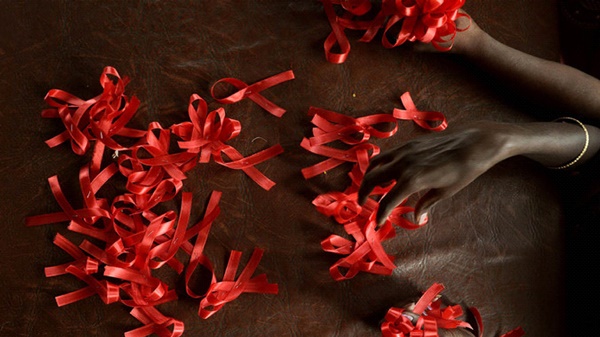
To mark the 25th annual World Aids Day, Deputy President Kgalema Motlanthe – who is also the chairperson of the National Aids Council – and Health Minister Aaron Motsoaledi, re-launched the country’s HIV counselling and testing campaign in Piet Retief in Mpumalanga.
Over 20-million people have been tested since the campaign was launched in 2010. According to the National Aids Council, the country has six million people living with HIV, a third of whom are on treatment. In 2012 there were an estimated 370 000 new HIV infections and 240 000 Aids deaths. South Africa has the biggest HIV treatment programme in the world, with about 2.4-million people on treatment.
Also part of the day’s events is the drive for men to get circumcised. Studies have shown that medical circumcision – the removal of the entire foreskin – reduces a heterosexual male's risk of contracting HIV by up to 60%. More than one million men between the ages of 15 and 49 have been circumcised since the government launched medical circumcision as part of its HIV prevention efforts in 2010.
However, the Treatment Action Campaign – an HIV activist organisation – says government efforts to curb the scourge of HIV are being undermined by a shortage of medicines and mismanagement. The group accuses provincial MECs of failing to live up to national commitments. The organisation plans to conduct a silent march in Piet Retief on Sunday.
"We feel attention must be drawn to the serious problems in the health system in the area. It will not help people to know their status if they cannot get access to ARV treatment, counselling or quality healthcare," the organisation said in a statement. "We cannot celebrate while clinics do not have stock of essential HIV and TB medicines, while hospitals run out of food and important equipment."
Last week a report by the pressure group Stop Stock Outs Project said that at least one in every five public health facilities have run out of HIV or TB medication. The project, which consists of Section27, Médecins Sans Frontières (MSF) and the Treatment Action Campaign, said the drug shortages have become a national crisis.

"All of the 97 Australian AIDS Memorial Quilts we have acquired are now on line and can be viewed here
Australian AIDS Memorial Quilts
The Museum's fabulous team of volunteers have also been documenting (as much as we can ) information on the individual panels and are up to Quilt 88 so by early next year (2014) the panel information will be up in detail.
I also developed an exhibition last year HIV & AIDS 30 years on: the Australian story
HIV and AIDS 30 years on: the Australian story


HIV/AIDS ISSUES PART 5 (Quilt Displays)


| Photos
of the Groves |

Mannie has a personal web site: RED JOS: HUMAN RIGHTS ACTIVISM
Mannie's blogs may be accessed by clicking on to the following links:
MannieBlog (from 1 August 2003 to 31 December 2005)
Activist Kicks Backs - Blognow archive re-housed - 2005-2009
RED JOS BLOGSPOT (from January 2009 onwards)

This page updated 15 MAY 2014 and again on 8 MAY 2017
PAGE 109